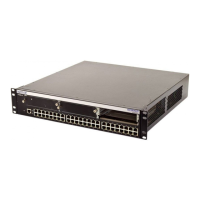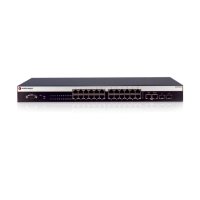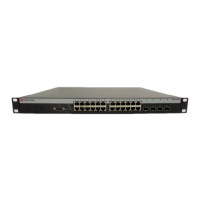Configuring Spanning Tree Bridge Parameters show spantree stats
6-8 Spanning Tree Configuration
Thisexampleshowshowtodisplayport‐specificSpanningTreeinformationforportge.1.1.
Table 6‐2describestheport‐specificinformationdisplayed.
Matrix(rw)->show spantree stats port ge.1.1
Spanning tree status - enabled
Spanning tree instance - 0
Designated Root MacAddr - 00-e0-63-93-79-0f
Designated Root Priority - 0
Designated Root Cost - 0
Designated Root Port - 0
Root Max Age - 20 sec
Root Hello Time - 2 sec
Root Forward Delay - 15 sec
Bridge ID MAC Address - 00-e0-63-93-79-0f
Bridge ID Priority - 0
Bridge Max Age - 20 sec
Bridge Hello Time - 2 sec
Bridge Forward Delay - 15 sec
Topology Change Count - 5
Time Since Top Change - 00 days 03:16:54
Max Hops - 20
SID Port State Role Cost Priority
--- ---------- ---------------- ----------- -------- --------
0 ge.1.1 Blocking Disabled 20000 128
Table 6-2 Port-Specific show spantree stats Output Details
Output... What it displays...
SID The Spanning Tree instance.
Port The port name.
State The Spanning Tree forwarding state of the port. This value can be Blocking,
Forwarding, Listening, or Learning. If the port/SID has been placed in a non-
forwarding state for a reason other than normal Spanning Tree protocol
operation, an asterisk will be displayed next to the state. You can use the show
spantree nonforwardingreason command (“show spantree
nonforwardingreason” on page 6-77) to display the specific reason.
Role The Spanning Tree role of the port. The port role is assigned by the Spanning
Tree protocol and determines the behavior of the port — either sending or
receiving BPDUs, and forwarding or blocking data traffic.
Cost The port cost.
Priority The priority of the link in a Spanning Tree bridge. This value can be set with the
set spantree portpri command (“set spantree portpri” on page 6-55).

